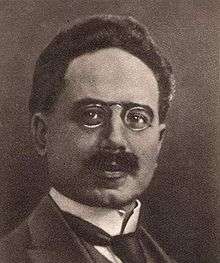Die Rote Fahne
 | |
| Type | Daily newspaper |
|---|---|
| Founder(s) |
Karl Liebknecht Rosa Luxemburg |
| Publisher | Spartakusbund |
| Founded | 1918 |
| Headquarters | Berlin |
| ISSN | 1862-0450 |
The German newspaper Die Rote Fahne ("The Red Flag") was created on 9 November 1918 by Karl Liebknecht and Rosa Luxemburg in Berlin, most famously as organ of the left-wing revolutionary Spartakusbund.[1]
History of newspaper
1876
de:Wilhelm Hasselmann of the Socialist Workers' Party of Germany and member of the German Reichstag founded a short-lived, weekly newspaper called Die rote Fahne.[2]
1918-1933

Using the newspaper's subtitle as indicator of its political allegiance, Die Rote Fahne was successively the central organ of:
- Spartacus League: 9 November 1918 to 30 December 1918
- Communist Party of Germany": 1 January 1919 to September 19, 1920 (reflecting the KPD's submission to the Comintern on
- Communist Party of Germany: 19 September 1920 to roughly 23 March 1933 (date of passage of the Nazi Enabling Act[2]
Many prominent Germans and others worked on the newspaper:
- Founders included: Rosa Luxemburg, Karl Liebknecht, Paul Frölich
- Publishers included" Hans Marchwitza and Johannes R. Becher
- Editors included: Ernst Meyer (1918-1919), August Thalheimer (1919-?), Julian Gumperz (1920? -- later, second husband of Hede Massing), Werner Scholem (1920--?), Gerhart Eisler (1921-?? already, first husband of Hede Massing), Arkadi Maslow (1921-?), Heinz Neumann (1922-1928?), Max Matern (1925-?), Hans Lorbeer (1928--?), Erika Heymann (1930-1933), Albert Norden (1930-1933), Lutz Łask (1930s and husband of Franz Kafka's lover Dora Diamant), Franz Koritschoner, György Lukács, Wolfgang Harich (1923 – 1995)
- Contributors included: Emil Barth (1918?), Lilly Becher (1921--?), Willi Schlamm (1923--?), Albert Hotopp (1923-1926), Erich Mielke (1928-131), John Sieg (1928-1933?), Jürgen Kuczynski (1930-1933), Max Zimmering (1935-1938?)
- Artists included: John Heartfield
1933-1946
Outlawed after the end of the Weimar Republic and the Reichstag fire in 1933, it was illegally distributed during the Nazi dictatorship by underground groups close to the Communist Party until 1942.
Newspaper in history
1918-1919

On January 15, 1919, Freikorps soldiers arrested co-founders Rosa Luxembourg and Karl Liebknecht, interrogated, and shot them.[2]
Ban 1923-1924
The longest ban on the newspaper ran from October 1923 to March 1924, as part of the ban on the German Communist Party. The newspaper continued in illegal production and distribution, sometimes renamed "Rote Sturmfahne" ("Red Storm Flag") or "Die Fahne der Revolution" ("The Flag of the Revolution").[2]
1926-1933
In 1926, the newspaper moved into the Karl Liebknecht House, to which it added in July 1928 a rotary press.[2]
On August 24, 1930, the newspaper published the last KPD program before its ban in 1933. Its title was "Program Statement for national and social liberation of the German people." The program deviated from Stalinist imperialist policy by opposing "forcible annexation of a people or a nation part of other national state structure... without [that people's] consent."[2]
During the 1932 elections, the newspaper ran the KPD slogan "Who chooses Hindenburg, selects Hitler who votes for Hitler votes for war" and supported the KPD candidate Ernst Thalmann for president.[2]
On February 23, 1933, Nazi police occupied Karl-Liebknecht-Haus and closed it the following day, anticipating the Nazi ban on all communist and socialist press after the Reichstag fire a few days later (February 28, 1933).[2]
Online archives
Staatsbibliothek zu Berlin contains the following:
- Ausgaben für das Jahr 1918
- Ausgaben für das Jahr 1919
- Ausgaben für das Jahr 1920
- Ausgaben für das Jahr 1921
- Ausgaben für das Jahr 1928
- Ausgaben für das Jahr 1929
- Ausgaben für das Jahr 1930
- Ausgaben für das Jahr 1931
- Ausgaben für das Jahr 1932
- Ausgaben für das Jahr 1933